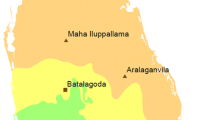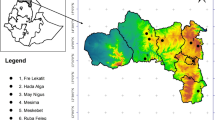Abstract
Irrigation scheduling services (ISS) provide farmers with recommendations on timing and amount of irrigation, thus contributing to improving on-farm water management. There are wide variations in the level of services, from providing regional water use guidelines to local, on-farm advisory services. An ISS (ISS-ITAP) was created in 1988 in Albacete, Central Spain, a province encompassing 100,000 ha which are irrigated mostly with groundwater. The ISS-ITAP first offered general information on crop water requirements (ET), and after 1994 field-specific scheduling services were provided to growers. By 2005 the ISS-ITAP had expanded its services to over 33,500 ha, corresponding to about 30% of the irrigable area. The evolution of irrigation performance in a number of individual farms was followed over 10 years, and it was found that the proportion of fields which were adequately irrigated increased from 50 to over 70% in that period. Meanwhile, the proportion of deficit-irrigated fields declined from 20 to 10%, while the proportion of over-irrigated fields which also had initially decreased from 20 to 10%, went back to 20% at the end of the study period. To assess the benefits and costs of the ISS-ITAP, a comparison of the yields achieved in the scheduled farms against those obtained in the rest of the province was carried out. When the Service was evaluated in economic terms, using information from 2003, the pay-back was 2 years and the internal rate of return was 59.1%, highlighting the high returns on the public funds invested by ISS-ITAP to provide irrigation advisory service to growers in the Albacete province.






Similar content being viewed by others
References
Alam M, Duke HR, Orendorff W (1996) ET information used by Colorado farmers. In: Camp CR, Sadler EJ, Yoder RE (eds) Proceedings of the international conference on evapotranspiration and irrigation scheduling. ASAE, San Antonio, pp 626–631
Allen RG, Pereira LS, Raes D, Smith M (1998) Crop evapotranspiration. Guidelines for computing crop water requirements. FAO Irrig Drain Pap 56, Rome, 300 pp
Bjornlund H, Nicol L, Klein KK (2009) The adoption of improved irrigation technology and management practices-a study of two irrigation districts in Alberta, Canada. Agric Water Manage 96:121–131
Boesch BE, Humpherys AS, Young D (1981) How scheduling fits in the irrigation program in the grand valley of Colorado. In: Camp CR, Sadler EJ, Yoder RE (eds) Proceedings of the international conference on evapotranspiration and irrigation scheduling. ASAE, San Antonio, pp 159–165
Dockter DT (1996) AgriMet-the pacific northwest cooperative agricultural weather station network. In: Camp CR, Sadler EJ, Yoder RE (eds) Proceedings of the international conference on evapotranspiration and irrigation scheduling. ASAE, San Antonio, pp 870–873
Doorenbos J, Pruitt WO (1977) Guidelines for predicting crop water requirements. FAO Irrig Drain Pap 24(rev), FAO, 144 pp
Eching S (2002) Role of technology in irrigation advisory services: the CIMIS experience. In: Proceeding of workshop on irrigation advisory services and participatory extension in irrigation management. FAO-ICID, Montreal, pp 1–12
English M, Solomon K, Hoffman G (2002) A paradigm shift in irrigation management. J Irrig Drain E-ASCE, pp 267–277
Faci JM, Bensaci A, Slatni A, Playán E (2000) A case study for irrigation modernisation. I. characterisation of the district and analysis of water delivery records. Agric Water Manage 42:313–334
Fereres E (1996) Irrigation scheduling and its impact on the 21st century. In: Camp CR, Sadler EJ, Yoder RE (eds) Proceedings of the international conference on evapotranspiration and irrigation scheduling. ASAE, San Antonio, pp 547–553
French RJ, Schultz JE (1984) Water use efficiency of wheat in a Mediterranean- type environment. I. The relation between yield, water use and climate. Aust J Agric Res 35:743–764
Goldsmith H, Bird JD, Howarth SE (1988) Computerised irrigation scheduling using spreadsheet models. Irrigat Drain Syst 2:211–227
González-Dugo MP, Mateos L (2008) Spectral vegetation indices for benchmarking water productivity of irrigated cotton and sugarbeet crops. Agric Water Manage 95:48–58
Howell TA (2001) Enhancing water use efficiency in irrigated agriculture. Agron J 93:281–289
Jensen MJ (1981) Summary and challenges. In: Proceedings of the ASAE’s irrigation scheduling conference, Irrigation scheduling for water & energy conservation in the 80s, Am Soc Agric Engr St. Joseph, ASAE Publications 23–81, pp 225–231
Klocke NL, Schneedloth JP, Watts DG (1996) Leaching from best irrigation management in semi-arid climate. In: Camp CR, Sadler EJ, Yoder RE (eds) Proceedings of the international conference on evapotranspiration and irrigation scheduling. ASAE, San Antonio, pp 769–774
Leib B, Elliott T, Matthews G (2001) WISE: a web-linked and producer oriented program for irrigation scheduling. Agric Water Manag 33:1–6
Leib B, Hattendorf M, Elliott T, Matthews G (2002) Adoption and adaptation of scientific irrigation scheduling: trends from Washington, USA as of 1998. Agric Water Manag 55:105–120
López Urrea R (2004). Evapotranspiración de Referencia: Métodos de cálculo y de medición directa en una estación lisimétrica en ambientes semiáridos. Doctoral Thesis, Universidad de Castilla-La Mancha, Albacete
Lorite I, Mateos L, Fereres E (2004) Evaluating irrigation performance in a Mediterranean environment. II. Variability among crops and farmers. Irrig Sci 23:85–92
Lyford G, Schild N (1981) The water management and conservation program in Yolo County, California. In: Phene CJ, Stegman EC (eds) Proceedings of an irrigation scheduling conference on irrigation scheduling for water and energy conservation in the 1980s. ASAE, Chicago, pp 179–185
Malano H, Burton M (2001) Guidelines for benchmarking performance in the irrigation and drainage sector. Proceedings of international programme for technology and research in irrigation and drainage, FAO, p 50
MAPA (Ministerio de Agricultura, Pesca y alimentación) (2004) Anuario de Estadística Agraria 2004. http://www.mapa.es/es/estadistica/pags/anuario/Anu_04/indice.asp. Accessed 3 March 2005
Martín de Santa Olalla F, Brasa A, Fabeiro C, Fernández González D, López Córcoles H (1999) Improvement of irrigation management towards the sustainable use of groundwater in Castilla-La Mancha, Spain. Agric Water Manag 40:195–205
Montoro A (2008) Avances en el manejo del agua en la agricultura de riego. Doctoral Thesis, Universidad de Castilla-La Mancha, Albacete
Montoro A, López Fuster P (2005a) Informe técnico para la toma de decisiones en el “plan de explotación 2005”, de la unidad hidogeológica de la mancha oriental. In: AP IT (ed) Anuario Técnico ITAP. Albacete, España, pp 19–26
Montoro A, López Fuster P (2005b) Los Servicios de asesoramiento de Riegos: el ejemplo del SAR de Albacete. In: de Martín Santa Olalla F, López Fuster P, Calera A (eds) Agua y Agronomía. Madrid, Spain, pp 435–466
Montoro A, López Córcoles H, López Fuster P (2002) An advisory service for irrigation in the plains of La Mancha, Spain. Proceeding of workshop on irrigation advisory services and participatory extension in irrigation management. FAO-ICID, Montreal, p 14
Nguyen HV, Nieber JL, Misra D (1996) Modeling BMP impacts on ground water quality. In: Camp CR, Sadler EJ, Yoder RE (eds) Proceedings of the international conference on evapotranspiration and irrigation scheduling. ASAE, San Antonio, pp 762–768
Ortega JF, de Juan JA, Tarjuelo JM (2005) Improving water management: the irrigation advisory service of Castilla-La Mancha (Spain). Agric Water Manag 77:37–58
Qiao G, Zhao L, Klein KK (2009) Water user associations in inner Mongolia: factors that influence farmers to join. Agric Water Manag 96:822–830
Quiñones P, Unland H, Ojeda W, Sifuentes E (1999) Transfer of irrigation scheduling technology in Mexico. Agric Water Manag 40:333–339
Sadras VO, Angus JF (2006) Benchmarking water-use efficiency of rainfed wheat in dry environments. Aust J Agr Res 57:847–856
Shearer MN, Vomocil J (1981) Twenty-five years of modern irrigation scheduling promotional efforts. In: Phene CJ, Stegman EC (eds) Proceedings of an irrigation scheduling conference on irrigation scheduling for water and energy conservation in the 1980s. ASAE, Chicago, pp 208–212
Silva WLC, Marouelli WA (1996) Evaluation of irrigation scheduling techniques for processing tomatoes in Brazil. In: Camp CR, Sadler EJ, Yoder RE (eds) Proceedings of the international conference on evapotranspiration and irrigation scheduling. ASAE, San Antonio, pp 522–526
Smith M, Muñoz G (2002) Irrigation advisory services for effective water use. A review of experiences. Proceeding of workshop on irrigation advisory services and participatory extension in irrigation management. FAO-ICID, Montreal, p 16
Soil Survey Staff (2006) Keys to Soil Taxonomy, 10th edn. USDA-Natural Resources Conservation Service, Washington, DC
Stamm GG (1967) Problems and procedures in determining water supply requirements for irrigation projects. In: Hagan et al. (eds) Irrigation of agricultural lands. Wisconsin, Amer Soc Agron Agronomy II
Tacker P, Ashlock L, Vories E, Earnest L, Cingolani R, Beaty D, Hayden C (1996) Field demonstration of arkansas irrigation scheduling program. In: Camp CR, Sadler EJ, Yoder RE (eds) Proceedings of the international conference on evapotranspiration and irrigation scheduling. ASAE, San Antonio, pp 974–979
Whittlesey N (2003) Improving irrigation efficiency though technological adoption: when will it conserve water? In: Alsharhan AS, Wood WW (eds) Water resources perspectives: evaluation, management and policy. Elsevier Science, Amsterdam, pp 53–62
Acknowledgments
This study and the whole ISS-ITAP were financially supported since its inception by the Diputación Provincial de Albacete, Castilla-La Mancha, Spain. E.F. also acknowledges the support of the Consolider-Rideco grant from the Ministry of Education and Science of Spain.
Author information
Authors and Affiliations
Corresponding author
Additional information
Communicated by J. Kijne.
Rights and permissions
About this article
Cite this article
Montoro, A., López-Fuster, P. & Fereres, E. Improving on-farm water management through an irrigation scheduling service. Irrig Sci 29, 311–319 (2011). https://doi.org/10.1007/s00271-010-0235-3
Received:
Accepted:
Published:
Issue Date:
DOI: https://doi.org/10.1007/s00271-010-0235-3




